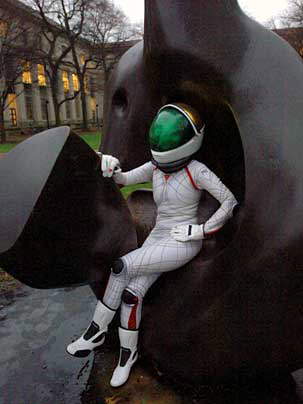It's been a while since I have done a reading update. In part that is a function of the fact that I haven't been reading as much or as fast as I used to. My library is still growing albeit at a much slower pace. I have started reading a lot more about the Mesozoic extinctions as of late, but also trying to keep myself from burning out wrt mass extinctions at the same time. I am suffering from burnout in general, but I have a couple things I want to do before I start to look for a new scene, so to speak, among those things are to try to do a break-in on the mass extinction scene with a paper or two. To do that, I need the resources at hand here.
First off, my last science fiction book that I read was to finish of Reynolds'
Absolution Gap. Eh. There were a few good points to this, butt he character that I actually liked and cared - or perhaps at least found interesting - about from the last book gets offed in a rather nasty way in the first few pages. Then the bad guys are not the bad guys because there are worse bad guys than the bad guys and humanity is about to suffer the same fate as the new bad guys...blah. I think I am going to pass on Reynolds for the time being. At least until there's something noteworthy that's not in the same universe.
To continue my fascination with Rome-Byzantium, I read the dated, but interesting read of
Lord Mahon's Life of Belisarius. Wow. This guy is
so overrated in the alternate history and science fiction writing department. It's not to say that he didn't do great things. It's not to say that he isn't a character I'd like to read more about in the future. It's just that he's been far overexposed in the specific writing genera and you'd expect him to have at least whupped the Visigothic collective ass handily with the reputation he has in so many ATLs. Oh, and this book dates itself based on the author's opinions. It's
soooo 19th century.
Continuing my Deep Time reading especially wrt mass extinctions, I picked up and read a few different books. Readers of my blog, family members, and people I've interacted with online know I find deep time absolutely fascinating. When I was a small kid, not much older than my daughter, I could name some thirty different genera of dinosaurs.
First Deep Time book was Ward's
Rivers in Time. I was disappointed with it in some respects just because I ahd been expecting something different. Ward had made a lot of noise about rivers and how they change based on his geological observations while hunting mass extinctions. I had been hoping that there'd be some more expose about the subject as part of the writing. For some reason I had even gotten it in my head that he'd referenced this book when writing about that subject in Gorgon and elsewhere. Well, I was wrong. This was just a general discussion of all the mass extinctions and the ongoing 6th Mass Extinction. Bummer. While the writing was definitely readable, it lacked the solid rock substance of
Out of Thin Air and spent far too much time on travelogue. This is a common issue with paleo books: either they spend too much time on the history and personalities of the subject or they spend too much time on the travelogue. Ward's books tend to do the latter.
The second book that I read was a translation of Vincent Courtillot's
Evolutionary Catastrophes. It was an engaging read. Courtillot is far more gracious than others in the field wrt mass extinctions and his commentary towards those that disagree with him or his position. He is of the camp of the vulcanists. That is to say that volcanoes are to be blamed regularly and repeatedly for the mass extinctions throughout Deep Time. The other major camp is the impactists who blame impacting bollides, fwiw. Courtillot argues both cases in his book (very well too) and concedes at least for the KT Event that a bollide is probably to blame. He has been vindicated wrt the Permian Extinction though.
The third book was something of a read from the horse's mouth: I read Walter Alvarez's
T. rex and the Crater of Doom. As you might guess, Alvarez is a Tolkien fan, hence, the title. It mostly a personal memoir about the journey of the first steps to proposing what happened at the KT Boundary - though that was not the intent at all - and the current state of the debate. It does talk about missteps along the way and some less than flattering moments by people on the team. It's worth a read.
My round out for Deep Time books at this point was Rich and Vickers-Rich's
Dinosaurs of Darkness. If you want to read about some pretty extreme field work, by all means, this is the book for you: blasting to tunnel for fossils on a sea cliff! That is the book's primary focus. I knew that was going to be the case before I read it. However, it does include some nifty science bits that make it worth reading. The dino they named for their daughter probably lived through the dark of winter without hibernating while a bird mimic did not. They talk about their mammal discoveries as well and have some very (!!!) controversial speculation in there as well. I'll put up a post on that later today with luck and smiling computational gods. I actually recommend the book, btw, despite what the amazon reviewer stated because there is a bunch of good juicy bits as well as some odd ball field work.
Following
Carlos Yu's recommendation of some time ago, I read Joseph Tainter's
The Collapse of Complex Societies as a counterpoint to Jared Diamond's
Collapse. While Diamond emphasizes the environmental reasoning of collapsing societies, Tainter subsumes that and other theories into an economic theory of how societies fall apart. It's a rather good read. It's a bit heavy at times due to its high info density and needs to be put down and thought about, but I do definitely recommend it. Diamond's book is light and fluffy. This one is a rich, heavy one that needs to be eaten carefully lest you suffer a surfeit. I am really glad that my wife just took two econ classes these last two semesters that I had to read up again on to help with homework at times or I would have been a little lost.
I have started a new book and its back to my Byzanto-Roman curiosity:
Warfare, State And Society In The Byzantine World 565-1204. I am about ten pages in, still the introduction, I'm afraid. After this, I suspect I'll be reading Charles Frankel's
The End of the Dinosaurs: Chicxulub Crater and Mass Extinctions. I really need to hunt more down for the Late Triassic Extinction and pick up some of Gerta Keller's work. If only it weren't so damned expensive!
We'll also have to see what I order next. It's going to be some more Deep Time stuff, I am sure, some on Russia, and some on cultural politics. I really need to read more on modern China. and even more on Mexico We'll see exactly what.





























